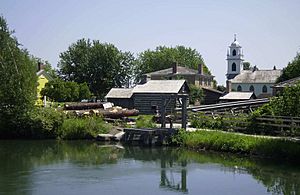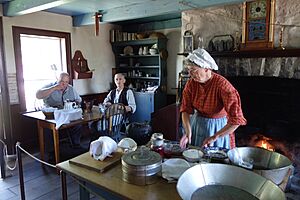Upper Canada Village facts for kids
 |
|
| Established | 1961 |
|---|---|
| Location | Morrisburg, Ontario, Canada. |
| Type | Living museum |
| Owner | St. Lawrence Parks Commission |
Upper Canada Village is a special place in Ontario, Canada. It's like a time machine that takes you back to a village in the year 1866. This "living museum" shows what life was like in Upper Canada during that time. You can find it near Morrisburg.
Contents
Discovering Upper Canada Village's Past
How the Village Began
Upper Canada Village started being built in 1958. This was part of a huge project called the St. Lawrence Seaway. The Seaway project changed the St. Lawrence River to make it easier for ships to travel. But it also meant that ten communities nearby, known as The Lost Villages, would be flooded forever.
To save important buildings from these villages, many were carefully moved. They were brought to the new site of Upper Canada Village. This helped preserve the history of the area.
Opening Its Doors
The St. Lawrence Parks Commission owns and runs Upper Canada Village. It first opened to visitors in 1961. Since then, it has been a popular spot for people to learn about the past.
Other Lost Villages History
Some other buildings from the Lost Villages were moved to Ault Park. There, the Lost Villages Historical Society runs another living museum. It also helps tell the story of these communities.
Remembering a Battle
The park also has a special memorial. It remembers the Battle of Crysler's Farm. This important battle happened during the War of 1812. The land where the battle took place was also flooded by the Seaway project.
Exploring Life in 1866
Upper Canada Village shows what rural life was like in English Canada in 1866. There are over 40 historical buildings to explore. You can see working mills like a woollen mill, a grist-mill, and a sawmill. There are also shops for trades like blacksmiths, tinsmiths, and cabinetmakers. You can even see a cooper, a bakery, and a cheese-maker.
Daily Life and Activities
At the village, you can learn about farming from the past. They grow and process old types of vegetables. They also raise heritage livestock. Staff members dress in clothes from the 1860s. They show how people lived, worked, and had fun back then. They talk about home life, social events, music, and even politics and religion.
Village Gardens
The gardens in the village are also special. They feature the kinds of plants and flowers that were commonly grown in the summer of that time.
Upper Canada Village on Screen
Upper Canada Village has even been a movie set! The 1973 movie The Adventures of Tom Sawyer was filmed there. This version starred actors like Josh Albee, Buddy Ebsen, Jane Wyatt, and Vic Morrow.
Museum Connections
Upper Canada Village is connected to several important groups. These include the CMA. It also works with the CHIN. And it is part of the Virtual Museum of Canada.


